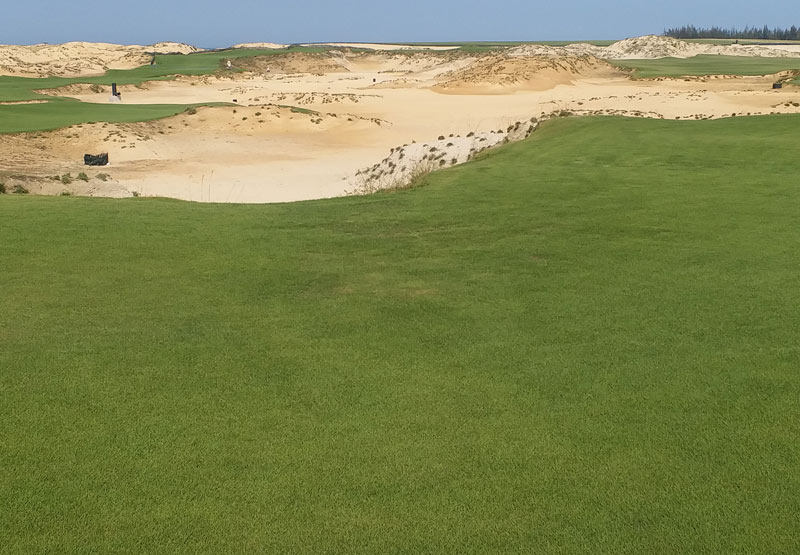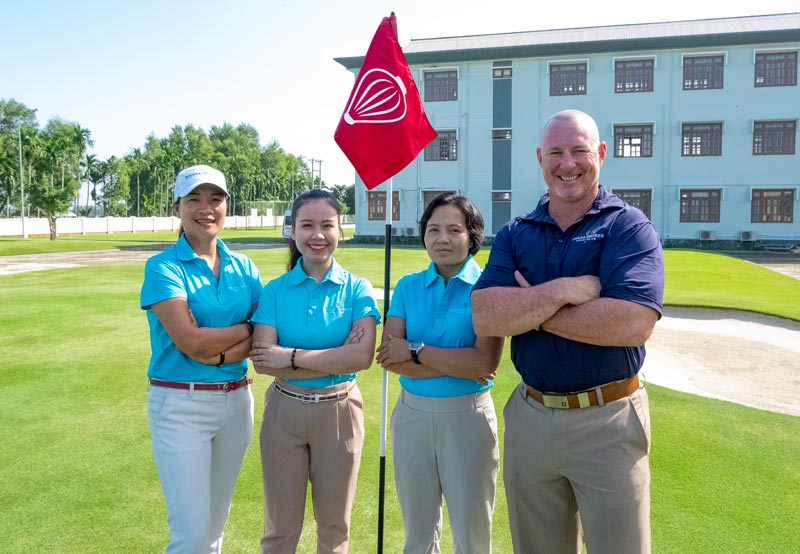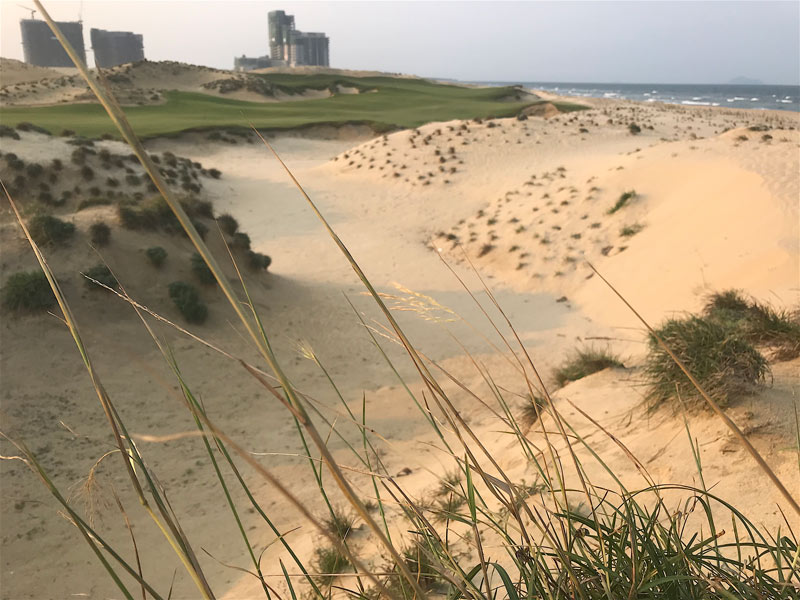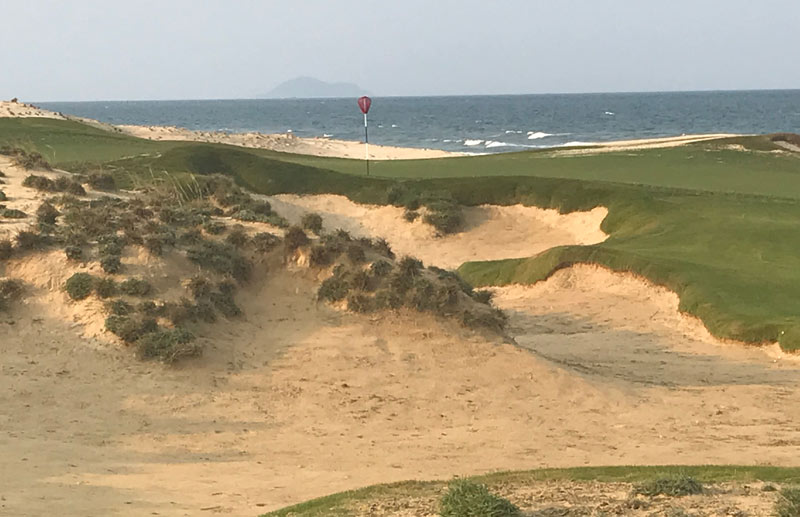
Zeon zoysiagrass graces an expanse of Hoiana Shores Golf Club, 18 holes of links golf along the coast of central Vietnam, set to open later this year. Photos courtesy of Hal Phillips
Superintendent Rob Weiks has been looking after golf courses in the tropical maelstrom of Vietnam since 2010. Throughout the course of his career, growing-in five courses and tending separately to half a dozen finished tracks, the Australia native has dealt extensively with the two warm-season grasses traditionally used in Southeast Asia: the various modern strains of bermudagrass and paspalum.
“I was actually sort of seen as a paspalum specialist,” says Weiks. “I was at Van Tri Golf Club in Hanoi — that was paspalum, Sea Isle 2000 and Salam. I went to Star Golf, which was all bermuda. Then I went and did some cool-season stuff. But then I did the grow-in at Saigon Golf Club with paspalum, and bermuda greens. I got that job because of my experience at Van Tri. When the Saigon GC job dissolved, I got the job at Twin Doves (Golf Club), which was all Platinum paspalum.”
Today, Weiks is the head golf course superintendent at the new Hoiana Shores Golf Club along Vietnam’s central coast, a Robert Trent Jones II design that developers, architects and turf nerds across Southeast Asia are watching very closely.
The property is a sea of sand directly on a beach, just a few miles from the UNESCO World Heritage City of Hoi An. Not surprisingly, Jones and his team have designed a full-on links course. Such layouts are rarities in this part of the world, and part of the reason why is that bermudagrass and paspalum have traditionally failed to deliver the firmness, bounce and roll that links features require.
Hoiana Shores will instead feature Zeon zoysia everywhere but its putting surfaces (those will be TifEagle bermudagrass). If the Zeon — and Weiks — can deliver the play characteristics folks expect from a true links course, Hoiana Shores will represent something of a game changer for superintendents, developers and golfers in Southeast Asia.

Hoiana Shores Golf Club superintendent Rob Weiks (right) with fellow members of the instructional staff at the Golf Operations and Maintenance Vocational College in Quang Nam, Vietnam. Read about Hanoi Shores’ innovative approach to employee training and retention.
“I’ve worked with Zoysia matrella at a couple courses, but never the Zeon until I arrived here,” Weiks says. “I’d heard good things about it, seen some decent results, mainly in Thailand. My skepticism has always been the same with the zoysia: extended grow-in time, extended recovery time from divots. That’s its weakness. On the other hand, its shade tolerance — which won’t be an issue here with our site — and playability in this instance is superior to paspalum and way better than bermuda.”
That’s the irony in a great many warm-season locations around the world: Yes, the heat and humidity are tropical, but daily afternoon showers (and the extended cloud cover that brings them) are also a fact of life in central Vietnam, just as they are in central Florida.
“Shade and light intensity are big issues here in Vietnam,” says Weiks. “In Hanoi, for example, you might not see the sun during the day for six weeks. That’s huge. In the wet season, it rains every day, and the soil doesn’t have time to dry out. You need a plant that can handle that stress. That’s where the Zeon shines. It has the strong rhizome growth to handle that. It will pull in more UV red light. It has the rhizomatous growth and can store the carbohydrates, the sugars, so it can draw on those carbs later, during the rainy season, when it needs to.
“Technically, that’s what a super does in much of Asia — you get the root growth and a strong carb load in the dry season so you can make it through the wet season. That’s what we do here, in a nutshell. That’s what you do anywhere with a warm-season grass — proactive turf management. I guess you could say we try to make hay while the sun shines.”
In the spotlight
As it happens, there are a lot of different eyes on the Hoiana Shores project, for a host of reasons:
- Upon full completion, this 985-hectare, $4 billion complex will be the most expensive resort development in Vietnam, which is saying quite a lot, as the country is perhaps the most active golf development market in the world. The finished resort will fully integrate some 1,300 rooms, suites and villas, 4 kilometers of beach, a retail village, a casino, and additional entertainment options.
- The construction of Hoiana Shores Golf Club has been executed by Hong Kong-based LinksShape in close consultation with Weiks and in full accordance with sustainability principles laid out by the U.K.-based GEO Foundation. “In Southeast Asia, there are no other golf developments at this stage of construction that are going through this program,” says Sam Thomas, executive director of GEO. “All others are in the planning or design stage. I think it’s fair to say that, if they continue on this path, Hoiana Shores will be first past the post — the market leader in this regard.”
- With more than 270 original designs in 40 countries, Robert Trent Jones II and his partner Bruce Charlton have distinguished themselves in the links milieu several times before, at places such as Chambers Bay in Tacoma, Wash. (site of the 2015 U.S. Open), The Links at Spanish Bay in Pebble Beach, Calif., and the new Hogs Head Golf Club in southwest Ireland. Hoiana Shores is the firm’s first project in Vietnam.
More to the point, perhaps, is that Hoiana represents the first proper links design ever undertaken in Southeast Asia, and it’s not at all clear what Vietnamese and regional golfers will actually make of it. Very few links courses exist anywhere in the region today.
On some level, this reflects the tastes of native golfers. The design genre of choice across Southeast Asia has typically been “tropical parkland,” lushly landscaped and not at all firm. Yet that preference has also been inextricably tied to the practical turfgrass choices available. Here again, Zeon zoysia may well change the game.
“It’s an upright grower where you can cut back on water and get it right — firm and fast,” says Charlton. “It’s less grainy than bermuda, way less than the paspalum. It’s what Gil Hanse used down on the Olympic course in Rio. That got our attention. It frankly freed us up to manufacture some wonderful shapes and contours — a lot of created architecture.”
Take a look at the magnificent terrain on which Hoiana Shores Golf Club sits, and hear from architect Robert Trent Jones II:
“You can have any sort of grass out here,” Weiks adds. “It all depends on who’s looking after it and how, to get the most out of it. Fescues and bent roll well because they’re upright in growth, which produces less resistance to ball roll. That’s the end game — playability. Celebration bermuda would work with all the right cultural practices. But the Zeon makes its own sense. The reason why it was chosen here was its really good upright growth. The growth characteristics of Zeon outweigh those of paspalum and bermuda, for our purposes. You can still get something close, something pretty good with other grasses like MiniVerde (ultradwarf bermudagrass) or Celebration, but we’d have to work harder to maintain a consistent, uniform surface if we deployed other warm-season varieties.”
Maintaining Zeon zoysiagrass
With 18 holes (plus a 19th “Gamblers” hole) fully stolonized and growing in at Hoiana Shores (the course is slated for a September 2019 soft opening), Weiks’ desire for links playability that’s both consistent and uniform centers on some key factors.
1. Grooming. “All our machines have grooming reels here. We’re unique in this, I think,” Weiks says. “Walking mowers, triplexes, fairway mowers — everything. That’s a huge factor. It gives us a better quality of cut, but it also encourages the plant to sit upright, pulls it upright. It basically trains it by virtue of constant vertical mowing, through frequency.”
Yet frequency, with Zeon, is a relative term. “The Zeon is slower-growing. It doesn’t require the same amount of mowing that paspalum or bermuda do,” Weiks says. “That means less man-hours devoted to actual mowing, less fuel, less oil. That’s appealing, because we’re looking to be as sustainable as possible here. That’s the real kicker for Zeon. You don’t have to mow it every day. There’s a reduction all the way around.”
In short, Weiks asserts, grooming takes on added importance when you’re doing less of it.
2. Cultural practices. “We can go topdress a green once a month, but we get more by dusting weekly,” Weiks says, noting that the practice leads to less sand on top and a better quality of cut. “We want to keep it from being anything a golfer will see.” This strategy fits with everything Weiks and his team do on the golf course in terms of fertility. “All the applications are geared toward keeping the plant at a growth rate that will result in a standard of play and aesthetics we’re looking to achieve.
“Things like foliar applications of calcium nitrate or potassium nitrate vs. granular feeds — the Zeon responds better to these (foliar) applications of nitrate, as opposed to a heap of granular. It can get thatchy if there’s too much nitrogen uncontrolled. We’re really trying to achieve this regimen where Hoiana Shores plays firm and fast in June and firm and fast in the wet season (October through to January). That’s links golf. And that’s the challenge in a tropical environment.”
3. Water use. Superintendents frequently acknowledge that today’s modern irrigation systems, with all of their bells and whistles, aren’t necessarily being used to their full potential. This won’t be the case at Hoiana Shores, however, as Weiks and his team are determined not to overwater a wind-blown site replete with a turfgrass that doesn’t need that much water.
“Gateway, the irrigation contractor, and Rain Bird have been very understanding of my expectation for water control here at Hoiana Shores,” Weiks says. “We have a lot of groundwater, but we’re not going to use it irresponsibly. The scheduling of our water use is entirely enabled by our Rain Bird IC system. We can effectively touch just a little bit of a golf hole if we choose.
“It’s all about individual head control, hitting the right spots in the right amounts. Because with all the contour and swales we have around the greens and fairways here, it would be easy to water the entire area like it’s flat. You walk on some tees here in Asia and it’s like walking on a water bed. That is not what we’re going to do here. Strong irrigation scheduling and understanding Zeon’s requirements mean we don’t have to do that.”


Nos. 16 (top) and 17 at Hoiana Shores.
Head control and strategic head placement allow Weiks and his team to set up different parameters for almost any situation. What’s more, dedicated use of what Weiks calls “Pogos,” or moisture meters, will play an integral role in where and how much water he and his team choose to put down, as the goal is to keep the surface playing firm, fast and consistent.
“For example, if we get a northeast wind, we’ll have a northeast wind irrigation program. The same for a southerly wind, etc.,” Weiks says. “I’ve been on 18 fairway when it was being grown in, and I’d get water droplets two holes over, because the site is so open, because of the strong winds here at seaside. We’re constantly adjusting what we do, according to what we see, because we can.
“It’s a very unique irrigation design. Lots of quick coupler valves. There is one every three lateral lines, two around every green, two or more around every tee; almost every bunker has a quick coupler. All this allows us to hook up a hose and syringe as needed. That’s pretty unique, how we control the water. It really does feel like the next level of irrigation scheduling. The greens here are quite big — No. 5 is 1,125 square meters. Almost 2.5 hectares in total for an 18-hole facility. This sort of irrigation control gives us the flexibility and efficiency we need.”
A cadre of zoysia growers
Weiks isn’t a Zeon pioneer/guinea pig in the extreme sense. Several other golf courses around the globe have successfully deployed the grass, and Weiks made sure to connect via email with folks like Eric Bauer, director of agronomy at BlueJack National outside Houston, where a Tiger Woods design was sodded with Zeon zoysia in 2015.
“He was really good; he came right back to me and he gave me all the answers,” Weiks says of Bauer, adding that everything Bauer related wasn’t too much of a surprise. “It was more confirmation — that I was on the right track, a validation of our approach. Still, it was good to gather a few little things in terms of cultural practice — how often, how aggressive, etc.
“That’s one of the things I really like about our industry — the high-end guys don’t put on any airs. More often than not, they’re eager to be of help.”
Weiks includes among his Zeon consigliore the zoysia growers Brad Burgess and John Gibb at Sports Turf Solutions. His day-to-day rock, though, has been Darry Koster, an American who was the longtime superintendent at Clearwater Bay Golf & Country Club in Hong Kong and is now director of projects with LinksShape, the Hoiana Shores contractor.
“When I first got to Hoi An, I took Darry out to lunch,” Weiks says. “Had I not pulled on that plethora of information, it might have been an opportunity missed. But I did, and Darry’s been more than just helpful. He’s so smart, with so much experience in this region. Such a valuable asset.
“My attitude is, I can never know enough. Even if it’s something I already know, there may be a twist on it that helps me. This isn’t rocket science, but it is a science.”
Hal Phillips is the managing director of Mandarin Media, an international digital/content marketing firm. He is the former editor of Golf Course News.